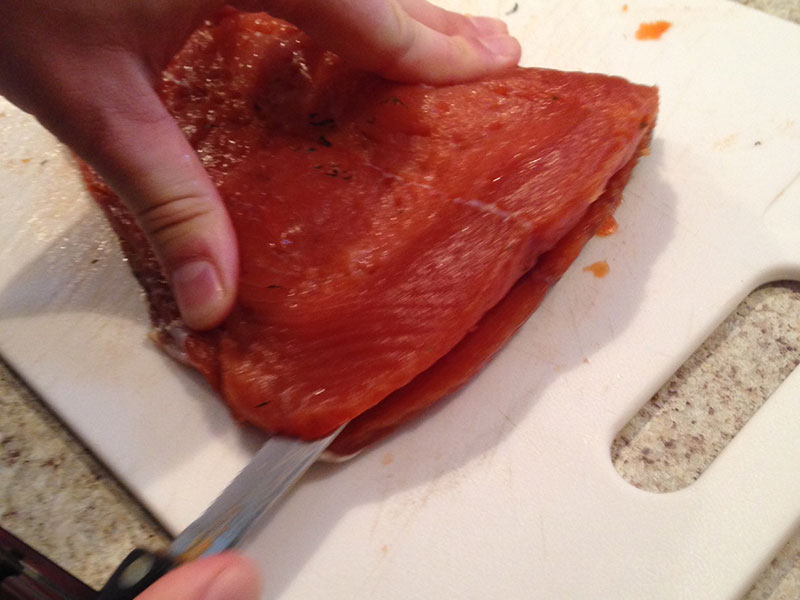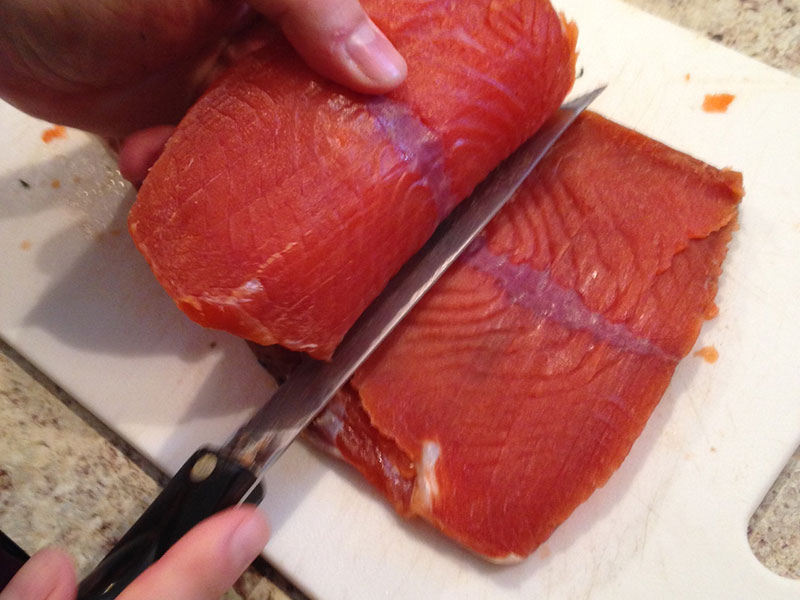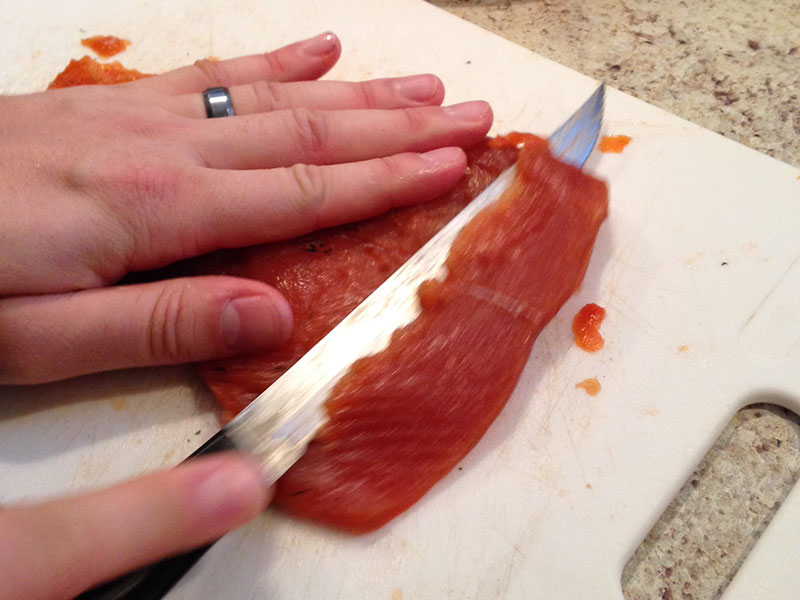This is Part 2 in my experience on making gravlax. You can read Part 1 here.
So a few days ago I took my first stab at making gravlax, a Scandinavian cured salmon dish which I’ve recently fallen in love with.
Today I’m going to show you how everything turned out after the 48 hour curing process, show you how to prepare and serve your gravlax post-curing, and tell you what went right, what went wrong, and what I’m going to do differently next time.
Removing from the fridge
First step is to remove your curing gravlax from the fridge, uncover it from all the things you had it weighing down with, and then drain it from the brine that has accumulated.
One of the videos I watched just showed the cook wiping the salmon down with kitchen paper, but that didn’t seem to have much effect on my gravlax. I actually had to rinse it under cold water to get all the dill and spice mix off.
Once you’ve rinsed away the mix, put your salmon on a plate and get out a cutting board.
Trimming away the skin
I honestly had a lot of trouble with this part, but I think it’s because I’m not that experienced with this step. Nonetheless here’s how I removed the skin:
1. Start cutting from the edge at an angle
Using a long knife, start at an angle near the wide edge of the fish and cut down toward the skin, leveling off as you get close to the skin. Keep slicing forward in slow, steady strokes.

2. Keep cutting slowly while peeling gently up on the cut fillet
As you cut, feel free to peel the fillet up and away from the skin as this may help you see what you are doing and get close to the skin as you cut.

3. Trim any excess meat at the skin
Once you’ve fully cut the fillet away from the skin, you may see some high spots of meat that are worth going back and trimming off to keep. Don’t be ashamed to do this! This stuff is pricey and delicious - get as much as you can from your work.

Slice the fillets into thin strips
Once you have your fillets all cut away from the skin, now it’s time to cut them into thin strips. One of the halmarks of traditional gravlax is that it is thinly cut at an angle from the fillet. I’ve seen it done other ways, and that’s okay. But if you want to do it the traditional way just just thin strips at an angle.

Store the extra
The gravlax will keep for up to 2 weeks. Make sure you keep it in an airtight container.
I’ve heard some say only slice what you need for a serving, but feel free to slice it all at once as long as you are storing it well and eating it quickly.

Ways to prepare
There’s lots of ways to serve gravlax. Basically anything you would do with smoked salmon you can do with gravlax! You can serve it as a breakfast snack on a bagel with cream cheese, you can serve it as a main course on it’s own with a side of spring mix lettuce and mustard sauce (a.k.a. “Ikea style”), or you can make an appetizer out of it.
For an example I prepared some by putting them over melba toast wafers with a dolop of sauce I made. The sauce is basically just the extra dill, along with some stone ground mustard and sour cream.

Things I’ll do differenty next time
I have to be honest: I was pretty disappointed with how mine turned out. There’s a handful of things that I think I’ll do differently next time:
- So I made a big mistake which I didn’t document here: a day before it was almost done curing, I watched another video of a chef preparing gravlax. He took a slightly different approach and covered the skin with the salt/sugar mix too. After I watched it I thought, “Hmm, wonder if I should do that?” So I took my curing salmon out of the fridge, and covered all of it on both sides with a bunch more salt and sugar. That was a HUGE mistake because I think overall there ended up being way too much salt after that. In the end my gravlax is overpoweringly salty. If you stick to the original recipe you should be fine, but don’t add extra salt!
- In addition to the overpowering taste of salt, my gravlax also has the overpowering taste of ginger root. I used too much. Next time I think I’ll avoid the ginger root, lemon and maybe even the peppercorns entirely, just sticking to the salt/sugar/dill cure.
- I think I left my gravlax in too long. While I said to leave it 48 hours, I ended up leaving mine closer to 60 hours, and as a result (along with having way too much salt) I think it dried it out too much. It’s not nearly as moist as other gravlax I’ve had.
- I think I weighed mine down a bit too much. Next time I’m only going to use one or two cans. I think my salmon got too smushed, also contributing to it being not moist enough (part of the purpose of the weight is to help push the juices out).
In conclusion
If you try this dish, def take into consideration some of my tips in hindsight. If you follow the recipe closely though, and don’t deviate as I did, you should end up with a delicious and healthy traditional Scandinavian treat.
